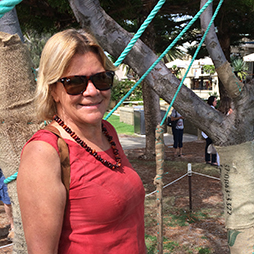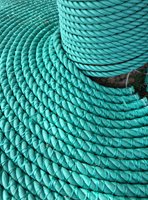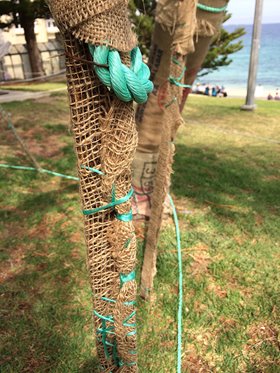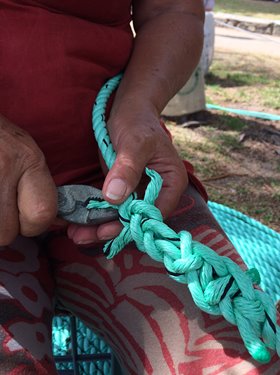 Weaving stories:
Weaving stories:
Sharyn Egan at Sculpture by the Sea
Words by Clothilde Bullen
Sculpture by the Sea is now in its twelfth year in Perth, based in and around the vibrant blonde sands at Cottesloe Beach, on the western edge of the Indian Ocean. Visitors to the exhibition and locals alike will be familiar with this ever changing and exciting display of sculptural works from international, national and local artists. The exhibition runs across three weeks free to the public, and is the largest annual display of public sculpture in the world.
This year for the first time Sculpture by the Sea announced the support of the Packer Family Foundation and Crown Resorts Foundation. Their significant philanthropic donation has funded an Indigenous Sculptor Support Program for 2016 and 2017, which ultimately aims to provide opportunities for Indigenous sculptors who wouldn’t necessarily participate in exhibitions such as these, and to make this kind of work accessible to a broad audience.
There are different elements to the program. The Invited Indigenous Artist Program provides $10,000 towards the selected artist’s costs of producing the work to be shown, including materials, freight, fabrication of the work and other associated costs such as travel to and from Cottesloe for those based outside of Perth, plus accommodation costs. Along with this, an Indigenous Employment and Vocational Training Program employs an arts worker during the exhibition period. There are multiple areas in which this person can be interned, including the Schools Education Program, within the Site Office or the ‘Sculpture Inside Gallery’, or as a member of the actual site crew.
 In its inaugural year, Sharyn Egan, a Wadjuk Nyoongar woman from the Perth area, has been invited to be the first participating artist. Sharyn began her practice as a returning student at the age of 37, under the tutelage of well-known Nyoongar artist Sandra Hill within the Indigenous arts course at Curtin University.
In its inaugural year, Sharyn Egan, a Wadjuk Nyoongar woman from the Perth area, has been invited to be the first participating artist. Sharyn began her practice as a returning student at the age of 37, under the tutelage of well-known Nyoongar artist Sandra Hill within the Indigenous arts course at Curtin University.
The work that Sharyn has made is an installation sculptural work, which in terms of form and style has resonance with a yurt, teepee or mia-mia. The process of making the work has been just as significant as the final sculptural weaving itself, and has been a labour of love for the artist. I sat down with Sharyn in the installation space of the work at Cottesloe Beach and talked with her about her practice and the way in which the work evolved. Here is a shortened version of that discussion.
Good Morning Sharyn! Can you tell me a little bit about you and about how you came to be involved this year with Sculpture by the Sea?
 “I was always a painter, and then about 10 years ago I went to a weaving class, and got into weaving, and met people like Nalda Searles (an acclaimed Western Australian weaver who has gained recognition for her work in promoting the skills of weaving). Now I’m into sculptural work and using weaving to sculpt work. This is my third time at Sculpture by the Sea. The first time was 2006 with the lovely Sarah Wilkinson. In 2011 I was invited back to do an ephemeral work, and then this year the Packer Foundation and Crown Casino have donated some funding to have an Indigenous artist.
“I was always a painter, and then about 10 years ago I went to a weaving class, and got into weaving, and met people like Nalda Searles (an acclaimed Western Australian weaver who has gained recognition for her work in promoting the skills of weaving). Now I’m into sculptural work and using weaving to sculpt work. This is my third time at Sculpture by the Sea. The first time was 2006 with the lovely Sarah Wilkinson. In 2011 I was invited back to do an ephemeral work, and then this year the Packer Foundation and Crown Casino have donated some funding to have an Indigenous artist.
I came down to the space and saw these beautiful Sheoaks, which I associate with Nyoongar women. They’re beautiful trees to sit under and when it’s quiet you can hear the whispering through the leaves – it’s beautiful. I get visits from the white cockatoo (Munarch) and the Crow (Wardang) all day and it’s wonderful because they are the two Nyoongar moieties. They’re always here and you can always feel them watching. There’s even a little djitty djitty (willy wagtail) that visits and sings his beautiful music.
This just seemed to fit in – weaving amongst the trees - and in weaving there are lots of things behind it, like weaving in stories, weaving in cultures. There are so many different people coming here – all the international people, when they just stop and have a yarn – it’s all weaving stories. There are all these connections. People from far away, they don’t speak much English, and we can still communicate. I’m building a little private room but very publicly.
There’s a clear transfer of knowledge and culture. It also triggers for me the idea that there are ‘outside lives’ and ‘inside lives’ and the vulnerability that comes with making private life public; was that a deliberate intention with the work?
No, it’s a bit evolved, everything’s sort of been intuitive; we’re problem solving as we go, new thoughts and ideas are happening as we go along as well. With me being here in the space I can explain things and talk about it, so this work is more personal (than the last work in Sculpture by the Sea). People are so interested, and they love that there is an artist on site. They usually go and see work and there’s no connection with the artist, or where it’s from; the reason for the piece.
 We’re sitting in the middle of the work at the moment; how would you describe this space?
We’re sitting in the middle of the work at the moment; how would you describe this space?
I started thinking a mia-mia would look nice in there and then I went a little away from that and was sort of thinking about bringing it more to the idea of a ‘fun’ space, because my original thought was bright fluoro pink rope to make it nice and fun! I went with this nice sea green – it reflects the trees and the ocean really nicely. Then I thought about a ‘green room’ – a nice space where people go and relax before they make their public appearance. Wheelchairs can fit in as well.
There’s a gentle reclamation of space with the work, in this place like Cottesloe, which is highly colonized and gentrified…
Yes, but then I sort of took it a little bit away from the fact that it’s an Indigenous work, starting with the idea of the woman and Sheoaks and mia-mia and now it is what it is – an inclusive and relaxed space. It (the Nyoongar presence in this space) is always there and always will be.
Clothilde Bullen is a Wardandi Nyoongar woman from south-west Western Australia. Formerly Curator of Indigenous Art at the Art Gallery for the last decade, she is now an independent Curator, a post-graduate student at the University of Western Australia and part-time Producer at Yirra Yaakin Theatre Company.